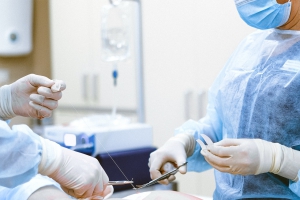3 Growth Trends in $472 Billion Global Medical Device Market

Personal protective equipment (PPE) was among the medical device segments that grew due to COVID-19.
COVID-19, mergers & acquisitions, and innovation spurred notable gains in the sale of medical devices in 2020
The global market for medical devices rose to $472 billion in 2020, increasing 5.1% for the year over 2019, according to new data published in The Global Market for Medical Devices, 11th Edition, the latest report by leading medical market research firm Kalorama Information.
The coronavirus pandemic in particular had a notable impact on medical device sales. The report reveals that COVID-19 related product demand impacted all markets, all regions, and all vendors to some degree in 2020, and has continued through the early months of 2021.
Kalorama Information forecasts the global medical device market will continue to grow more than 3% annually through 2025, with sales cooling down in 2022 as markets stabilize and economic recovery becomes prevalent. In 2023, growth is expected to reemerge and produce steady performance through the end of 2025.
Medical devices include any instrument, apparatus, appliance, machine, contrivance, implant, in-vitro device as well as any accessories or related components that facilitate any or some of the following functions pertaining to a disease, injury, or condition of handicap: diagnosis, prevention or monitoring, and treatment. Kalorama Information’s research shows that the largest individual categories of medical devices are:
- dental equipment, including products in the areas of preventive, restorative, orthodontics, endodontics, implants, prosthetics, CAD/CAM restoration systems (CEREC), digital intra-oral, panoramic and 3D imaging systems, dental treatment centers and instruments/handpieces;
- catheters, including any of the three major types of catheters: coronary, renal, and infusion catheters;
- dialysis equipment, including hemodialysis machines, bloodlines and dialyzers;
- endoscopes, which are designed for direct visual inspection of the interior of a body cavity, hollow organ, or structure;
- minimally invasive surgical instruments, which allow doctors to perform many complicated operations with a short hospital stay; and
- personal protective equipment (PPE), including various device segments with the indication of protecting both caregivers and patients from contamination or disease risk, such as face masks, surgical masks, filtering facepiece respirators, and protective clothing.
Personal Protective Equipment Segment Sales Increase 190% Due to Pandemic
Out of all the major medical device categories, the COVID-19 pandemic had a major hand in market growth for PPE during 2020. The market increased by more than 190% over 2019 as a result of the pandemic. It is expected that for 2021 and potentially some of 2022, health facilities and practitioners will continue to replenish shortages of PPE and prepare for additional unforeseen health pandemics in the future with some degree of stockpiling. Additionally, several governments around the world have placed orders for PPE in attempts to not be without this essential tool in the event of future pandemics.
M&A Activity Sees Billions of Dollars Exchanged
Beyond the impact of COVID-19, the overall medical device market is ripe with both acquisitions and innovation. Acquisitions drove growth, as there have been more than 300 significant device market mergers and acquisitions (M&A) since 2015. In total, this amounts to the exchange of more than $400 billion over the six years. And as of early 2021, there is nearly $40 billion in pending M&A activity in the medical device industry.
Innovation Essential to Emerging International Markets
In addition, companies operating in the market remain optimistic and seek innovation. Kalorama Information estimates that medical device companies spent an average of 8.2% of revenue on R&D during 2020, up from 8.1% in 2019. For example, innovations from Chinese manufacturers working closely with foreign companies include reusable sutures, portable ultrasound products, low-cost stents and patient monitors. Such innovations borne out of the Chinese healthcare market are important not only in steering foreign participants’ business development strategies, but also in establishing China as a base for greater exports to regional and overseas international markets. China is already home to an estimated 15,000-16,000 domestic medical device manufactures. The United States’ medical device market is the largest in the world, but China is one of several emerging markets that will continue to drive growth and innovation. Other emerging markets include India, Turkey, Romania, South Africa, Saudi Arabia, South Korea, Poland and Brazil.
For more insights like these, purchase The Global Market for Medical Devices, 11th Edition by Kalorama Information at https://kaloramainformation.com/product/global-market-for-medical-devices-11th-edition/.

